Mad Hedge Biotech and Healthcare Letter
December 10, 2024
Fiat Lux
Featured Trade:
(THE INSURANCE COMPANY ALWAYS RINGS TWICE)
(UNH), (CI), (CVS), (HUM), (AMGN), (BIIB), (GILD)

Mad Hedge Biotech and Healthcare Letter
December 10, 2024
Fiat Lux
Featured Trade:
(THE INSURANCE COMPANY ALWAYS RINGS TWICE)
(UNH), (CI), (CVS), (HUM), (AMGN), (BIIB), (GILD)

Got an interesting call yesterday from an old college buddy - let's call him Bob. We go way back to our UCLA days, before I headed to Tokyo and he went into tech.
He was fuming because UnitedHealth (UNH) just denied his family's third claim this year, something about an "experimental treatment" for his daughter's rare condition.
Coming from a guy who just cashed out of his third startup, hearing him rant about insurance bureaucracy was pretty rich.
Still, his situation got me thinking. After hanging up, I dug into what's really happening with insurance stocks, and the picture isn't pretty.
UnitedHealth Group, our nation's biggest health insurer, just had its worst week in years - dropping 9.5% after one of their executives was tragically murdered, which sparked an unexpected spotlight on their claims practices.
Cigna (CI) and CVS Health (CVS) caught the same downdraft, falling 4.5% and 5% respectively.
But here's what really caught my attention: UnitedHealthcare's denial rate for Medicare Advantage claims has more than doubled since 2020, hitting 22.7% last year.
Interestingly, this spike happened right as they rolled out new automation processes. Funny how that works, isn't it?
Experian Health's latest report shows this isn't isolated - 73% of healthcare providers are reporting more denials than ever, with processing times stretching longer and longer.
The cost of this trend? The Council for Affordable Quality Healthcare estimates $31 billion annually in administrative expenses alone.
Meanwhile, biotech companies find themselves in an awkward position. They're developing treatments that cost more than a house in the Hamptons and then need these very same insurers to make them accessible.
Amgen's (AMGN) been crushing it with their human therapeutics portfolio, pulling in $28.2 billion in revenue last year.
Biogen's (BIIB) making serious moves in neurological treatments, though their path has been rockier - just ask anyone who followed the Aduhelm saga.
Gilead Sciences (GILD), our antiviral champions, have managed to stay above the fray, partly because their HIV and hepatitis treatments have become standard of care.
But even these giants must wonder:: as insurers tighten their prior authorization screws, what happens to patient access?
These biotechs spend billions developing breakthrough treatments - Amgen alone dropped $4.4 billion on R&D last year - only to face the insurance industry's equivalent of "computer says no."
The irony isn't lost on anyone: insurers need innovative treatments to justify their premiums, while biotech needs insurance coverage to justify their R&D spending.
It's a delicate dance that's worked reasonably well so far, but these rising denial rates have everyone on edge. Just last quarter, we saw several biotech earnings calls dominated by questions about insurance coverage rather than clinical trials.
So what should we do? Well, I say UnitedHealth and Cigna are "holds" right now - the current turbulence needs time to settle.
CVS Health is showing broader operational challenges that suggest it might be wise to consider selling. But Humana (HUM), with their strong Medicare Advantage presence, looks promising.
On the biotech side, Gilead looks like an excellent stock to buy on the dip. Its leadership in antivirals and solid pipeline make it compelling.
Amgen and Biogen? Keep them on your watch list while they try to find their footing in this situation.
Bob texted me again this morning - turns out he's filing an appeal with help from one of Silicon Valley's top healthcare attorneys. Typical Bob, bringing a cannon to a knife fight.
But maybe that's exactly what this sector needs right now - some heavy artillery to shake up the status quo.
For those willing to dodge the crossfire, there might just be some spoils of war worth picking up. After all, fortune favors the bold—and sometimes, the heavily armed.
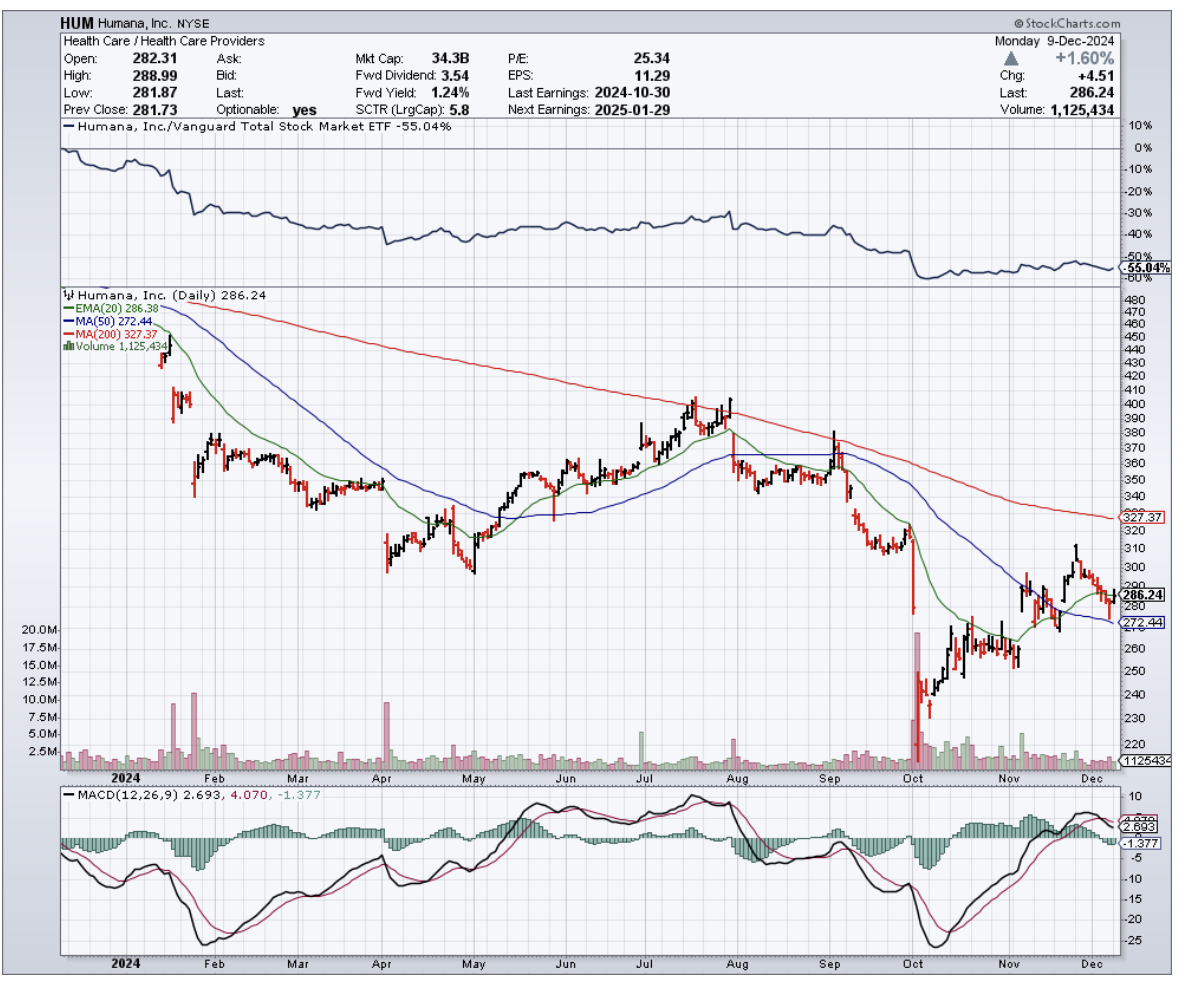
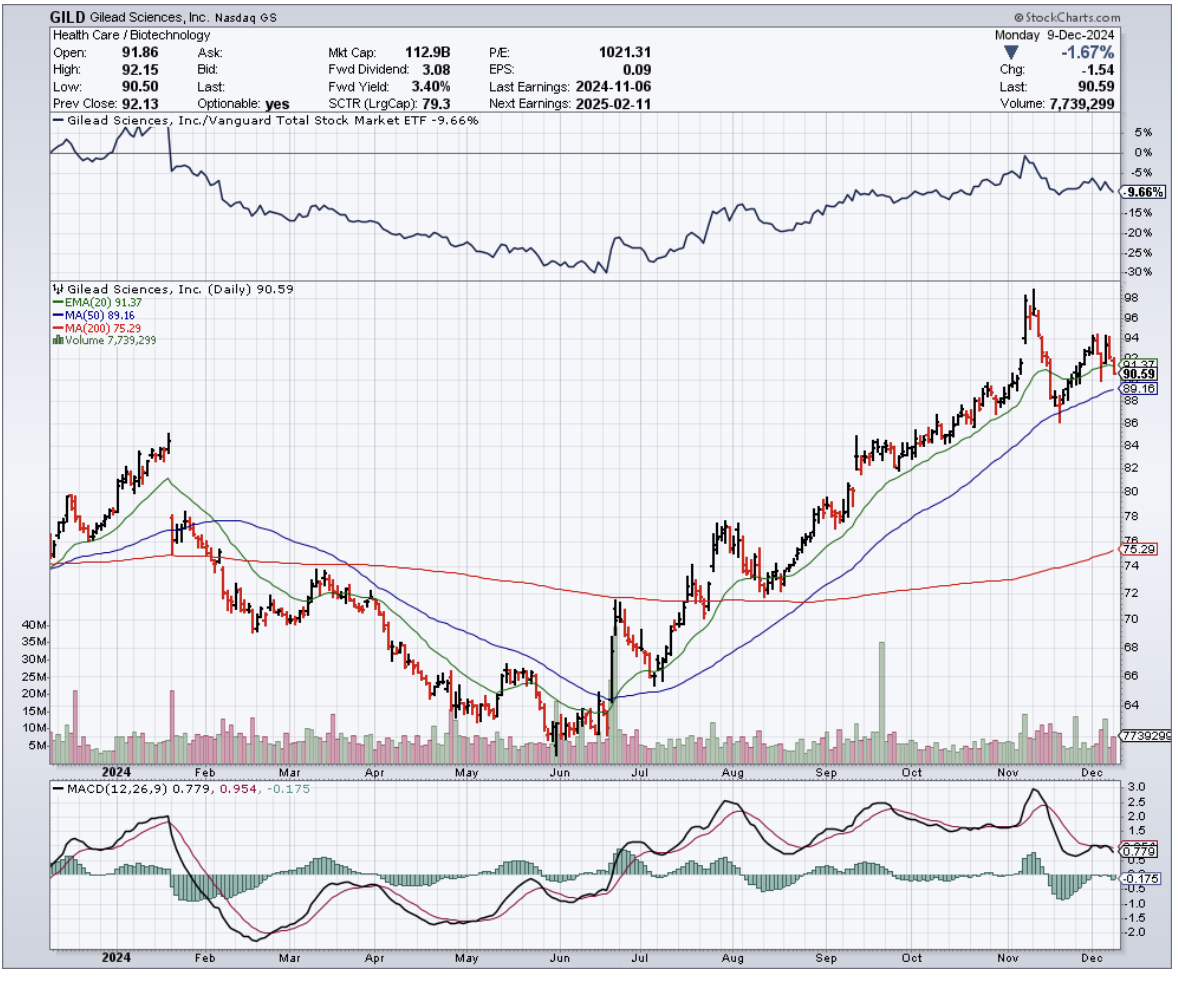
Mad Hedge Biotech and Healthcare Letter
November 21, 2024
Fiat Lux
Featured Trade:
(TRACE ELEMENTS)
(SNY), (MTZPY), (BIIB), (IONS), (AMLX)

In a corner office somewhere in Cambridge, Massachusetts, a team of scientists is attempting something that sounds like it belongs in a sci-fi novel: they're trying to reprogram the genetic instructions that tell our neurons how to behave.
If they succeed, they might help 97% of people with ALS keep their neurons from self-destructing.
Welcome to Trace Neuroscience, where $101 million in venture capital is betting on what amounts to a molecular spell-check for your nervous system.
You might be wondering, as I did, how one starts a company with the audacious goal of tackling one of medicine's most notorious puzzle boxes.
The answer, it turns out, involves three scientists, working in three different labs, who all stumbled upon the same cellular culprit – a protein called UNC13A - the sort of name that makes you wonder if scientists moonlight as license plate generators.
But to understand why UNC13A has everyone buzzing, we need to talk about ALS itself.
ALS, if you're not familiar with it, is the kind of disease that keeps neurologists up at night. Every year, it claims about 5,000 new victims in the US alone, and we still don't know what causes 90% of cases.
Here's a simple way to envision it – think of your nervous system as a complex metropolitan subway system.
ALS is like having someone systematically shut down every station, one by one, until the entire network grinds to a halt. Despite decades of research and millions in funding, we're still mostly watching helplessly as stations go dark.
Sure, the global market for ALS treatments reached $667.3 million in 2023, but that impressive-sounding number masks an uncomfortable truth: we're still barely keeping the lights on, let alone fixing the underlying problem.
The current FDA-approved medications, Sanofi’s (SNY) Riluzole and Mitsubishi Tanabe Pharma’s (MTZPY) Edaravone (marketed as Radicava), are like trying to stop a flood with a handful of sandbags. They might slow things down a bit, but they're not exactly what you'd call a solution.
So how do you tackle a troublemaker like UNC13A? Enter Trace Neuroscience's bold approach: antisense oligonucleotides, or ASOs for those who don't enjoy tongue twisters.
Think of ASOs as tiny molecular scissors that can edit the body's protein-making instructions with surprising precision - in this case, they're specifically designed to fix how UNC13A behaves when it goes rogue.
The science behind this approach comes from a rather serendipitous confluence of research.
Aaron Gitler at Stanford, Pietro Fratta at University College London, and Michael Ward at the NIH – three scientists who probably should have just gotten a group chat going – independently discovered how certain RNA-processing molecules go haywire in ALS patients.
It's like they each found a different piece of the same puzzle, and when they put them together, the picture suddenly made sense.
And where there's breakthrough science in biotech, money usually follows.
In November 2024, Trace managed to convince some of the biggest names in venture capital – Third Rock Ventures, Atlas Venture, GV (formerly Google Ventures), and RA Capital Management – to part with $101 million.
That's quite a vote of confidence for a company whose main product is still theoretical.
The timing couldn't be more interesting. The ALS treatment market is expected to grow at a rather specific 5.8% per year until 2030, reaching about $1.1 billion.
But in this field, even the success stories come with asterisks.
Take Biogen's (BIIB) Qalsody, which got FDA-approved in May 2024 despite not actually meeting its main trial goals.
It's a rare win in a field where the scoreboard has been mostly zeros, as the rest of the ALS treatment landscape makes painfully clear.
Ionis Pharmaceuticals (IONS) had to shut down their ALS program with Biogen in May 2024, and Amylyx Pharmaceuticals (AMLX) faced the bitter task of pulling their drug Relyvrio from the market in April 2024, laying off 70% of their staff in the process.
These setbacks illuminate an uncomfortable truth about ALS drug development: the path from lab bench to pharmacy shelf is paved with perfectly logical theories that simply didn't work in real bodies.
The math is brutal - only 6.2% of neurological drugs survive the journey from Phase I to approval. Trace's response to these odds? Assemble a team that's seen enough clinical trial failures to know how to (hopefully) avoid them.
Their CEO, Eric Green, M.D., Ph.D., leads a squad that includes Chief Medical Officer Irina Antonijevic and Chief Operating Officer Megan Baierlein.
They're aiming to start clinical trials by early 2026, which in drug development terms is practically tomorrow.
For investors, timing like this transforms Trace from a scientific curiosity into a near-term catalyst.
Their approach - anchored in genetic evidence and measurable biomarkers - stands out in a field where most companies are still shooting in the dark with better bullets.
The story of Trace Neuroscience reads like molecular medicine's version of going from medieval star-gazing to GPS navigation.
While traditional ALS treatments chase symptoms, Trace is tracking proteins with the precision of an atomic clock.
They've transformed one of medicine's most frustrating puzzles into something remarkably concrete: either their molecular markers will move, or they won't.
In the biotech world, that kind of clarity is worth watching.
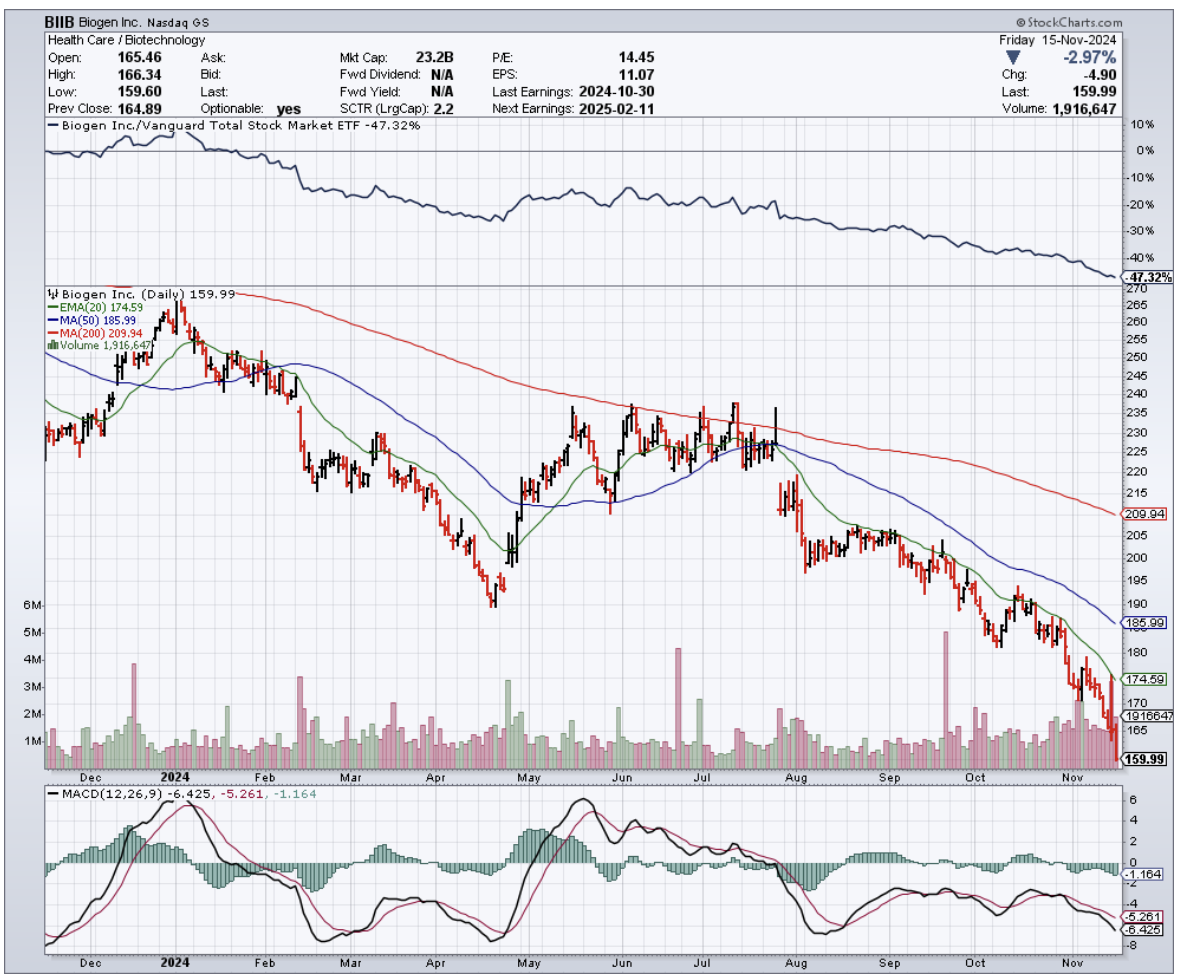
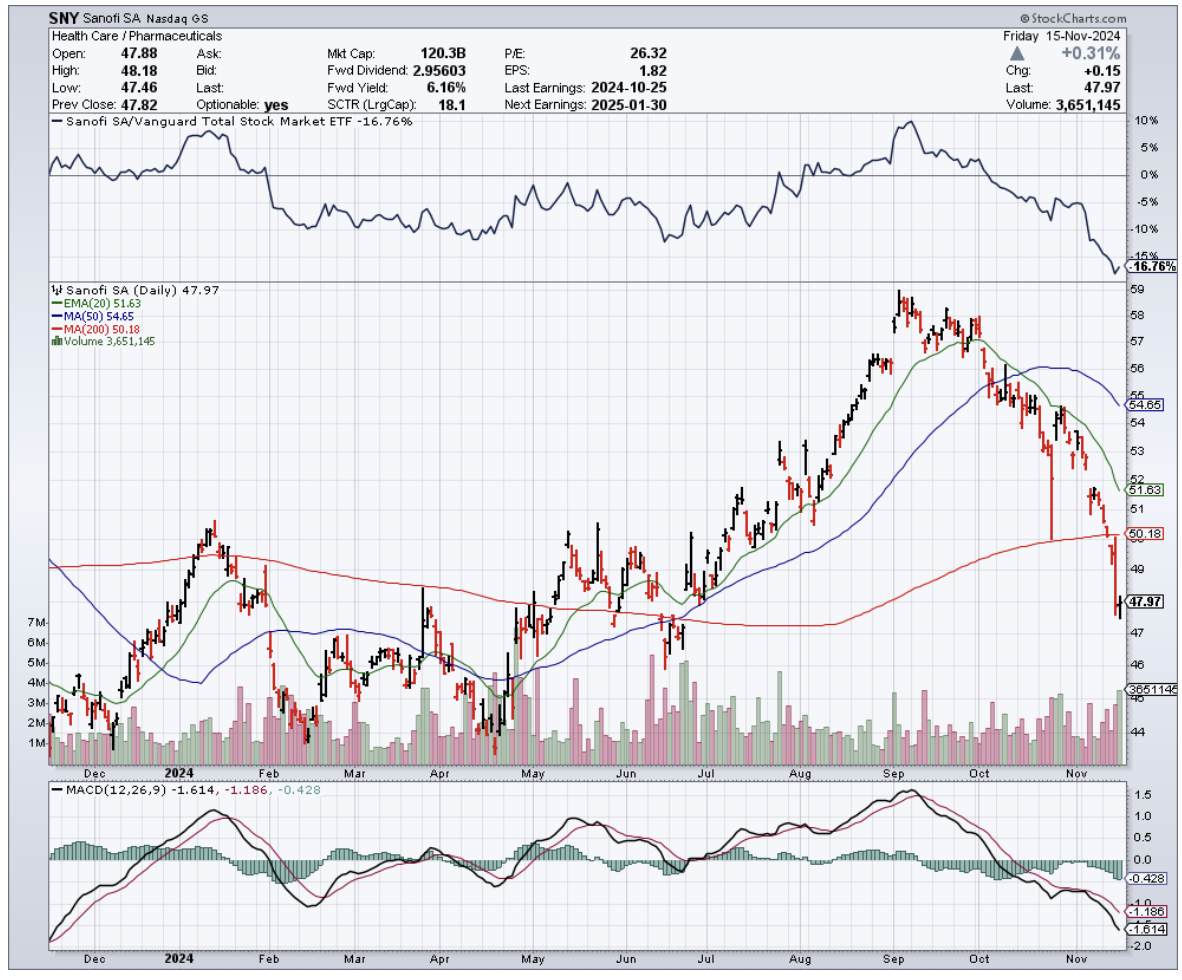
Mad Hedge Biotech and Healthcare Letter
November 5, 2024
Fiat Lux
Featured Trade:
(DANCING WITH SHADOWS)
(RHHBY), (SGMO), (LLY), (BIIB), (ABBV)

In 1906, Dr. Alois Alzheimer first encountered what he called a “mysterious” mental illness, examining the brain of a 55-year-old woman who had died under strange neurological circumstances.
Over a century later, that mystery hasn’t let up. We’re still scratching our heads—and burning through money.
By 2050, Alzheimer’s is projected to cost the U.S. healthcare system $1.3 trillion, more than the entire GDP of Australia.
But something’s happening at Roche (RHHBY) that’s got my scientific spidey senses tingling.
Roche has been chasing Alzheimer’s solutions for over two decades, pouring resources into this elusive brain burglar that defies every rule in the book.
And yet, here they are—undaunted, driven by a noble (and, yes, profitable) goal to relieve the massive toll AD takes on patients, families, and entire healthcare systems.
It hasn’t been smooth sailing; setbacks and “whoops, not this time” moments have kept things bumpy. Recently, though, I’ve been seeing hints of a breakthrough that just might bring this long, shadowy dance with Alzheimer’s closer to the light.
For those who've been reading my letter since 2008, you know I rarely get excited about big pharma unless there's real meat on the bone. Well, this time there is, and it's called Brainshuttle technology.
If you’ve never heard of it, think of it as a kind of souped-up delivery service for the brain—no, not that kind. This tech helps Roche’s meds cross the blood-brain barrier, that stubborn security guard that only lets a select few molecules into the brain.
It’s great at keeping out random junk but also frustratingly good at blocking drugs we actually want to get in there.
Brainshuttle could change that, allowing antibodies to cross over more easily and making lower doses (and hopefully fewer nasty side effects) possible.
Enter trontinemab, a drug that’s caught a lot of eyes recently. Armed with Brainshuttle, this amyloid-beta antibody is like the brain’s personal pest control.
Early trials are promising: Roche reported that trontinemab is sweeping out amyloid plaque faster than a Roomba on espresso, and all at lower doses.
Less dose, more punch, and fewer side effects? Sounds like the AD holy grail. They’re even eyeing an accelerated approval path with the FDA.
Now, the FDA isn’t exactly known for sprinting to approval—especially with Alzheimer’s drugs—but trontinemab’s early results make it a strong contender.
But Roche isn’t putting all its eggs in one beta basket. AD research has been dominated by amyloid-beta, but there’s another protein that scientists are pretty excited about: tau.
If amyloid-beta is the ringleader, tau is the muscle, the heavy that clogs up brain cells and wreaks havoc.
To tackle tau, Roche has teamed up with Sangamo Therapeutics (SGMO), a company with tech that sounds like it’s straight out of a sci-fi novel—zinc finger molecules.
These little DNA-grabbers are designed to silence the tau gene, essentially telling it to cool it and stop producing the stuff that clogs up the brain.
The partnership also gives Roche access to something else in Sangamo’s arsenal: an adeno-associated virus capsid. (Translation: a delivery mechanism that gets things across the blood-brain barrier.)
If these tools work as planned, Roche may have a real chance to give AD a one-two punch with both amyloid-beta and tau treatments.
But let's be real here. This is still the Wild West of biotech, and Roche has had its share of setbacks.
They recently walked away from a partnership with UCB, returning the rights to an anti-tau antibody called bepranemab.
Even though UCB called the Phase 2a data "encouraging," it apparently didn't meet Roche's internal bar. That's the thing about Alzheimer's drug development - it's about as predictable as my teenager's mood swings.
The competition isn't sleeping either. Eli Lilly (LLY), Biogen (BIIB), and AbbVie (ABBV) are all throwing everything but the kitchen sink at this disease. But Roche's Brainshuttle technology might just be their secret weapon in this fight.
Here's what keeps me optimistic: Roche’s multi-pronged strategy, combining amyloid-beta and tau, might just give them an edge. It’s not guaranteed—far from it—but having multiple avenues does give them a better shot at success.
This is what I call a "chess not checkers" opportunity. The potential payoff is massive - we're talking about a market that could make crypto's best days look like pocket change. But timing is everything.
So, I'll be watching trontinemab's development like a hawk. The Sangamo collaboration is also on my radar - any breakthrough in tau-targeted therapies could be a game-changer.
As always, don’t bet the farm, folks—not even on a biotech darling like this. But if you’re itching to add a little intellectual flair to your portfolio, Roche’s Alzheimer’s gambit is worth a look. Buy the dip, but set those stop losses. After all, even the best-laid plans of mice and biochemists often go awry.
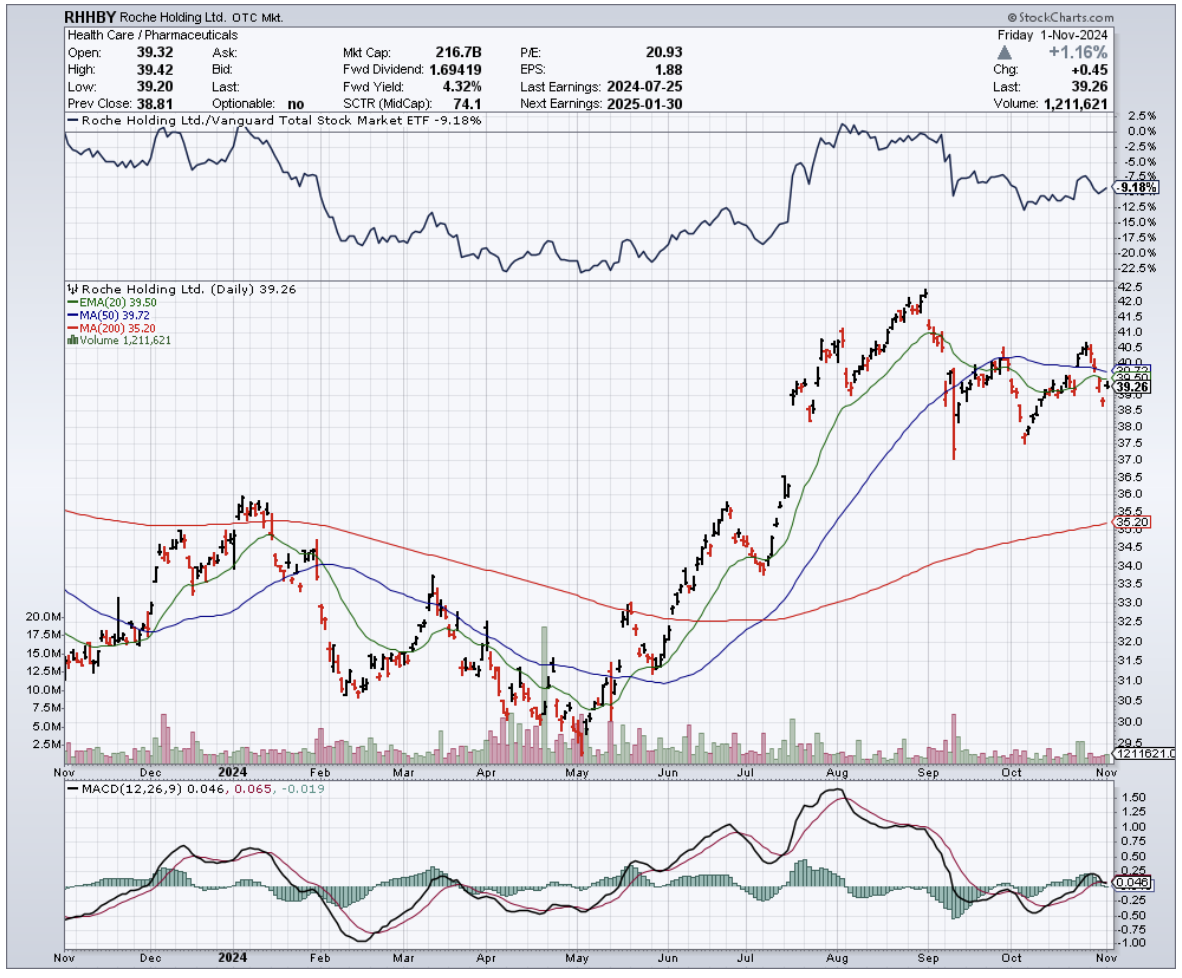
Mad Hedge Biotech and Healthcare Letter
July 25, 2024
Fiat Lux
Featured Trade:
(REVERSING THE FOG)
(SAVA), (ESALF), (BIIB), (LLY), (RHHBY), (ACIU), (AVXL), (ATHA)

Close your eyes and think back to your favorite childhood memory. Maybe it's the smell of your grandma's apple pie wafting through the kitchen, or the sound of your grandpa's belly laugh as he tickled you mercilessly.
Now imagine those memories being ripped away, one by one, until all that's left is a hollow shell of the person you once knew and loved.
That's the heartbreaking reality of Alzheimer's disease, and it's a fate that Rick Barry, the newly minted executive chairman of Cassava Sciences (SAVA), is determined to change.
You see, Barry isn't just some suit looking to make a quick buck. No, sir. This man's got skin in the game, and a personal connection to the fight against Alzheimer's that'll tug at your heartstrings.
His decision to join Cassava's board back in June 2021 was driven by a gut-wrenching story about his buddy's father, Buddy. This once-vibrant Navy fighter pilot and commercial airline captain was reduced to a shell of his former self by the cruel hand of Alzheimer's.
And folks, this ain't an isolated case. We're talking about 6.9 million Americans aged 65 and older living with this wretched disease in 2024, with that number set to double in the next 30 years.
Globally, over 55 million people are grappling with dementia, and Alzheimer's is the big, bad culprit in 60-70% of those cases.
While the situation is admittedly grim, Cassava Sciences offers a glimmer of hope: simufilam.
This experimental drug is Cassava's secret weapon, designed to whip a rogue protein called filamin A back into shape.
When filamin A goes off the rails in Alzheimer's patients, it wreaks havoc on brain function. But simufilam, like a disciplined drill sergeant, could get this unruly protein back in line, normalize cellular processes, reduce inflammation, and give synaptic function a much-needed boost.
Now, I know you're probably skeptical, but the Phase 2 trial results were nothing to sneeze at. A whopping 47% of patients saw their cognitive function improve, and the biomarkers of neurodegeneration and inflammation took a nosedive.
But the real moment of truth lies ahead in the Phase 3 trials, RETHINK-ALZ and REFOCUS-ALZ. These trials are the big leagues, with nearly 2,000 participants and top-line results expected by the end of 2024.
If simufilam can prove its mettle, it could be a game-changer for millions of Alzheimer's patients who are desperate for a breakthrough.
Of course, Cassava Sciences isn't the only horse in this race. The heavyweight contenders like Eisai (ESALF), Biogen (BIIB), Eli Lilly (LLY), Roche (RHHBY), and AbbVie (ABBV) are all jockeying for position, while smaller outfits like AC Immune (ACIU), Anavex (AVXL), and Athira Pharma (ATHA) are making some intriguing moves of their own.
But what really sets Cassava apart is the fire in their belly. When Barry says, "If you create great benefit for your patients, you'll create great value for your shareholders," you can tell he means business. This isn't just about lining pockets – it's about making a real difference in people's lives.
And let me tell you, the impact of Alzheimer's is staggering. Over 11 million Americans are providing unpaid care for their loved ones with Alzheimer's or other forms of dementia.
In 2023 alone, these unsung heroes clocked in a mind-boggling 18.4 billion hours of care, valued at a cool $350 billion.
And to make things worse, 70% of these caregivers are stressed to the max trying to coordinate care, while 66% are struggling to find resources and support. On top of that, 74% are also worried sick about their own health.
Financially, Alzheimer's is a beast that just keeps growing. In 2023, it drained $345 billion from the nation's coffers.
Fast forward to 2024, and that price tag is expected to hit $360 billion. And brace yourselves, because by 2050, we could be staring down the barrel of a $1 trillion problem.
So, is Cassava Sciences stock a slam-dunk investment? Well, that depends on your appetite for risk.
In the biotech world, the stakes are high, and the outcomes are never guaranteed. Simufilam's fate rests squarely on the results of those pivotal Phase 3 trials.
But one thing I can say with certainty is that Cassava Sciences has got guts. They're the underdog taking on Alzheimer's, armed with a potentially groundbreaking treatment and a whole lot of heart.
In a world where roughly 1 in 9 people over 65 are living with Alzheimer's, the impact of a successful therapy would be nothing short of seismic.
As investors, it's easy to get caught up in the cold, hard numbers. But sometimes, it pays to step back and consider the human element.
Behind every stock symbol, there are countless families praying for a miracle, tireless researchers burning the midnight oil, and brave souls like Rick Barry putting their money where their mouth is.
So, while I can't tell you to go all-in on Cassava Sciences just yet, I can tell you this: they're fighting the good fight. And in a world that often seems like it's gone completely off the rails, that's something worth getting behind. I suggest you buy the dip.

Mad Hedge Biotech and Healthcare Letter
July 23, 2024
Fiat Lux
Featured Trade:
(DON'T SLEEP ON THIS BIOTECH SLEEPER)
(ATHA), (BIIB), (LLY)

To date, 6.7 million Americans over 65 are already wrestling with Alzheimer's, a number set to double by 2050.
It's a demographic disaster, a slow-motion train wreck that Big Pharma's been slow to recognize.
Companies, including Biogen (BIIB) and Eli Lilly (LLY), working on this are still fiddling with amyloid plaques and tangled proteins, like a plumber trying to fix a leaky nuclear reactor with duct tape.
But one scrappy biotech outfit, Athira Pharma (ATHA), is taking a different tack. They're not chasing the same old tired targets.
Instead, they're looking at the brain's own repair mechanisms, trying to kickstart the engine instead of just patching up the exhaust. It's a high-risk, high-reward play, but isn't that what makes this game so damn exciting?
Athira targets the neurotrophic hepatocyte growth factor (HGF) and its sidekick, the MET receptor. Don't let the fancy names fool you - these little fellas are the unsung heroes of your noggin.
Think of HGF and MET as the brain's maintenance crew. They're not just sitting around twiddling their thumbs. They're constantly on the job, patching up neurons and keeping the lights on upstairs.
Athira's betting the farm that if they can juice up this dynamic duo, they might just be able to slow down the Alzheimer's wrecking ball, or heck, maybe even throw it in reverse.
It's a bold move, I'll give 'em that. While everyone else is trying to sweep up the mess Alzheimer's leaves behind, Athira's aiming to stop the party before it even starts.
If they're right, it could be like discovering fire all over again in the world of neuroscience.
Speaking of which, Athira's lead drug, fosgonimeton (try saying that three times fast), just hit a milestone that's got Wall Street perking up its ears. They've wrapped up dosing in their Phase 2/3 LIFT-AD trial for mild-to-moderate Alzheimer's.
We're talking about 315 patients who've been getting daily shots of this stuff (or a placebo) for 26 weeks. It's like a six-month-long neuroscience party, and we're all waiting to see who's left standing when the lights come on.
Interestingly, Athira's playing it smart with their ongoing Phase 2/3 LIFT-AD trial. They're using something called the Global Statistical Test (GST) as their primary endpoint. It's like they're giving themselves better odds at the casino.
This GST is designed to catch even the slightest whiff of a clinically meaningful treatment effect. It's like using a finely-tuned bloodhound instead of a myopic poodle to find your car keys.
And here's another thing that caught my attention: 85% of the folks from their trials signed up for the after-party - the open-label extension study. That's like people sticking around to help clean up after a rager.
When was the last time you saw that kind of enthusiasm for anything, let alone a clinical trial?
But Athira isn't content with just one target. They've also got fosgonimeton in the ring against Parkinson's with their SHAPE trial.
This Phase 2 slugfest has already shown some positive jabs on cognitive measures for patients with Parkinson's disease dementia and Dementia with Lewy bodies.
And because apparently two fights aren't enough, Athira's also thrown fosgonimeton into the ALS arena. This early-stage trial is like watching a fighter warming up in the gym - we don't know how it'll play out, but the potential is intriguing.
So, what’s next? Well, we’re now staring down the barrel of what could be the biggest shakeup in Alzheimer's research since... well, since we started researching Alzheimer's.
Athira's betting big on their HGF/MET approach, and if it pays off, we might be looking at the medical equivalent of striking oil in your backyard.
Mark your calendars for the end of Q3 2024. That's when we'll find out if fosgonimeton is the real McCoy or just another pie-in-the-sky biotech dream. And don't forget the fireworks show in Madrid this October - Athira's set to strut their stuff at the Alzheimer's conference, and you can bet your bottom dollar I'll be watching.
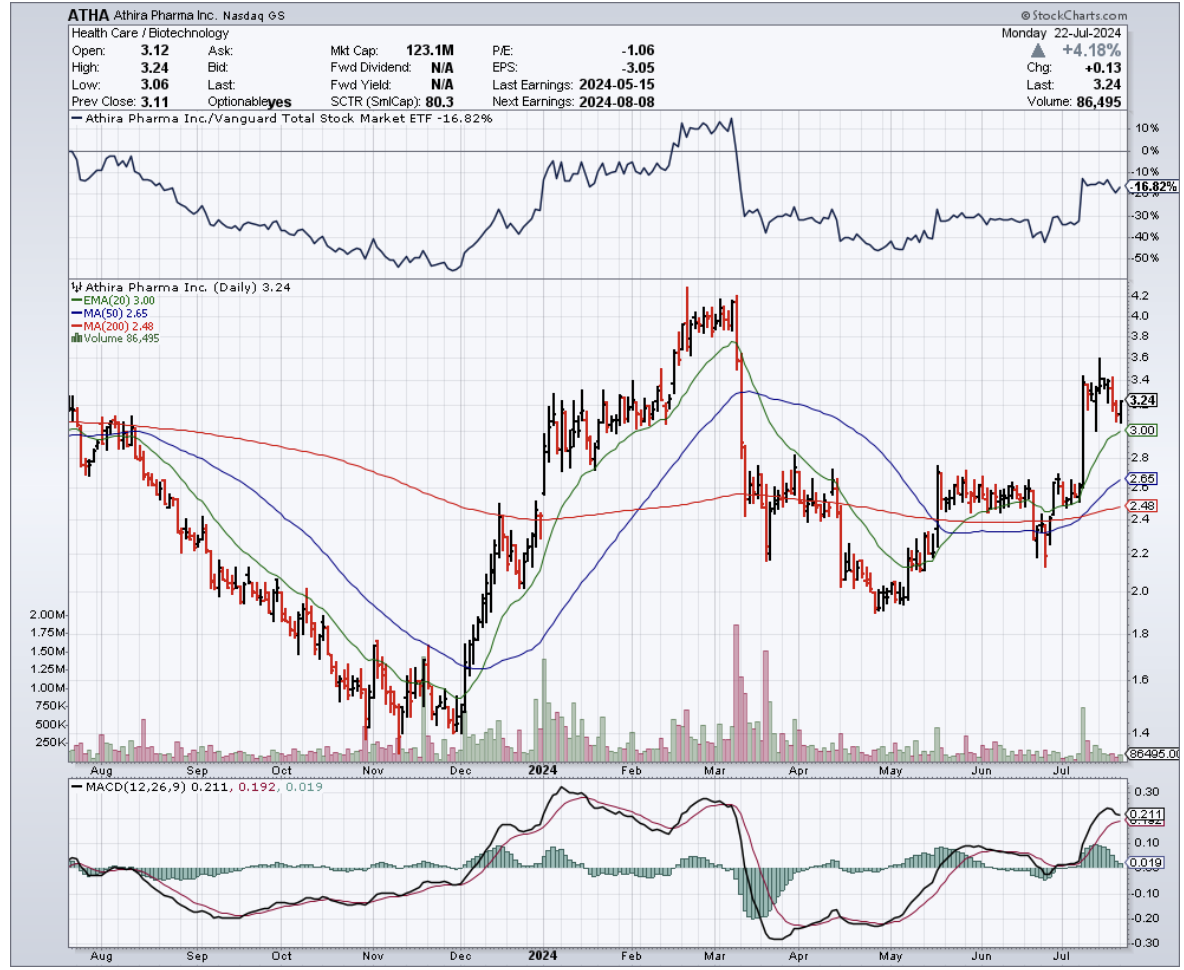
Legal Disclaimer
There is a very high degree of risk involved in trading. Past results are not indicative of future returns. MadHedgeFundTrader.com and all individuals affiliated with this site assume no responsibilities for your trading and investment results. The indicators, strategies, columns, articles and all other features are for educational purposes only and should not be construed as investment advice. Information for futures trading observations are obtained from sources believed to be reliable, but we do not warrant its completeness or accuracy, or warrant any results from the use of the information. Your use of the trading observations is entirely at your own risk and it is your sole responsibility to evaluate the accuracy, completeness and usefulness of the information. You must assess the risk of any trade with your broker and make your own independent decisions regarding any securities mentioned herein. Affiliates of MadHedgeFundTrader.com may have a position or effect transactions in the securities described herein (or options thereon) and/or otherwise employ trading strategies that may be consistent or inconsistent with the provided strategies.
This site uses cookies. By continuing to browse the site, you are agreeing to our use of cookies.
OKLearn moreWe may request cookies to be set on your device. We use cookies to let us know when you visit our websites, how you interact with us, to enrich your user experience, and to customize your relationship with our website.
Click on the different category headings to find out more. You can also change some of your preferences. Note that blocking some types of cookies may impact your experience on our websites and the services we are able to offer.
These cookies are strictly necessary to provide you with services available through our website and to use some of its features.
Because these cookies are strictly necessary to deliver the website, refuseing them will have impact how our site functions. You always can block or delete cookies by changing your browser settings and force blocking all cookies on this website. But this will always prompt you to accept/refuse cookies when revisiting our site.
We fully respect if you want to refuse cookies but to avoid asking you again and again kindly allow us to store a cookie for that. You are free to opt out any time or opt in for other cookies to get a better experience. If you refuse cookies we will remove all set cookies in our domain.
We provide you with a list of stored cookies on your computer in our domain so you can check what we stored. Due to security reasons we are not able to show or modify cookies from other domains. You can check these in your browser security settings.
These cookies collect information that is used either in aggregate form to help us understand how our website is being used or how effective our marketing campaigns are, or to help us customize our website and application for you in order to enhance your experience.
If you do not want that we track your visist to our site you can disable tracking in your browser here:
We also use different external services like Google Webfonts, Google Maps, and external Video providers. Since these providers may collect personal data like your IP address we allow you to block them here. Please be aware that this might heavily reduce the functionality and appearance of our site. Changes will take effect once you reload the page.
Google Webfont Settings:
Google Map Settings:
Vimeo and Youtube video embeds:
